What Your Camera Flash Has to Do With an Atomic Bomb
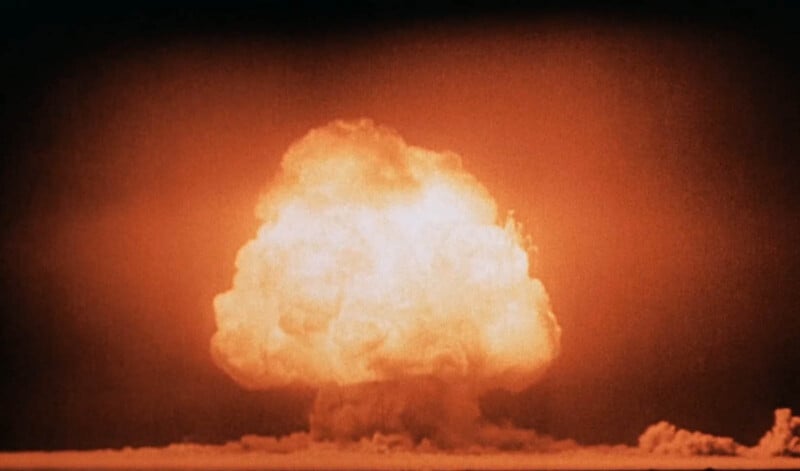
On July 16th, 1945, 35 miles southeast of Socorro, New Mexico, the White Sands Proving Ground was rocked by a massive explosion.
And the world changed forever.
What you might not know is that much of the flash equipment you and I use today can trace its lineage back to the people and objects that made that test possible. Let’s jump in.
A Nation at War
Of course, this was the Trinity Test, the culmination of the Manhattan Project, and the first-ever nuclear detonation successfully achieved on Earth.
But let’s back up and talk a bit about how we got there.
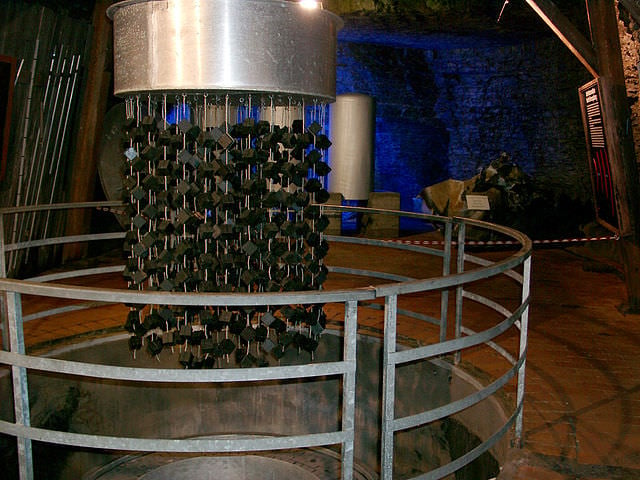
Prior even to the United States’ entry into Second World War, Nazi Germany had been heavily investing in nuclear research, seeing the development of technology that could harness the power of nuclear fission as a key component in their war strategy. First discovered in December of 1938, nuclear fission had seemingly limitless destructive potential, and those with power and influence in Germany knew it. Unfortunately for the Germans, many of the research projects on this subject were hamstrung by corruption, disorganization, and concurrent events in the war effort, meaning overall progress was slow.
After receiving the Einstein-Szilard letter (yes, that Einstein) in August of 1939, warning of the potential development by Nazi Germany of “extremely powerful bombs of a different type”, the United States quickly began investigating the creation of its own nuclear program. After just a month of deliberation, the Advisory Committee on Uranium, headed by Lyman Biggs, Leo Szilard, Eugene Wigner, and Edward Teller, advised President Roosevelt in November of 1939 that uranium “would provide a possible source of bombs with a destructiveness vastly greater than anything now known.” The next February, the US Navy awarded Columbia University $6,000 to begin its research, and the nuclear arms race was officially on.
Of course, the impetus for the United States officially entering the Second World War was the Japanese attack on Pearl Harbor in Honolulu, Hawaii, on December 7th, 1941. The attack came after months of tense negotiation attempts between the US and Japan over the future of the Pacific region and the relationship between the two countries.
Less than 24 hours afterward, President Roosevelt delivered his famous “Day of Infamy” speech, calling for an official declaration of war on Japan, a request granted in less than an hour by the joint session of Congress called to determine what was to be done. Due to some political nuance in the Tripartite Pact, Japan’s defensive agreement with Germany and Italy, the US was not officially at war with the latter two countries until a few days later, but by December 11th, America had fully committed to fighting on both the Pacific and European fronts, with formal declarations of war against all 3 counties.
Fickle Fission
By this point in the story, the United States and its allies were well on their way toward the construction of a functioning nuclear device. As of the summer of 1942, the Manhattan Project as we now know it had been officially organized and had begun research and development into the design of nuclear weapons.
To greatly simplify advanced nuclear theory, the basic premise of such a device is to assemble enough fissile material, whether uranium, plutonium, or some other element, in one lump that the radioactivity of that lump, called a “critical mass”, causes a “chain reaction”, releasing unimaginable amounts of energy through the splitting, or “fission”, of atoms. The more atoms split, the more atoms probably will split. The amount of material required for this to happen depends on how much volume the material takes up, meaning that you can create a critical mass if you can figure out a way to compress a sub-critical mass into a smaller space.
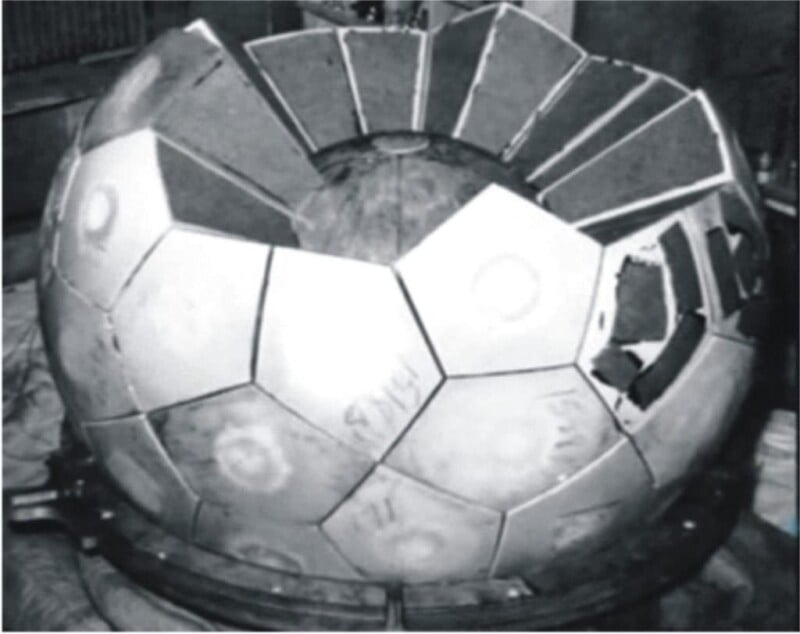
And wouldn’t you know it, those bright sparks at the Manhattan Project did just that. In September of 1943, mathematician John von Neumann put forward the idea of surrounding a core of fissile material with a special arrangement of two types of high explosives, Composition B and Baratol. Looking remarkably like a soccer ball, these two compounds would produce blast waves of different speeds, and by precisely calculating their position and shape, you could, in theory, turn their blast effectively inside-out, crushing the nuclear core into a volume small enough to force it into a critical state and generating the chain reaction that makes the whole thing work. In fact, this principle is actually called an “explosive lens”, since it bends a blast wave in the same way that a lens bends light.
There was only one small problem. High explosives detonate at velocities measured on the order of thousands of meters per second. Composition B, for example, detonates at 8,050 meters per second, meaning that in an arrangement small enough to fit into a bomb, the fuze going off even microseconds too early or too late would ruin the perfect inverted spherical blast wave and the bomb would likely fizzle (this is actually an official technical term-I’m serious).
Something had to be done.
Here in a Flash
Let’s pause talking about the Manhattan Project for a moment, to visit the US Army’s photographic laboratory at what is now Wright-Patterson Air Force Base. Major George Goddard, instructor of Aerial Photographic Interpretation, was struggling to find a way to obtain useful aerial reconnaissance from night missions, and so went straight to the top, visiting MIT in 1939 to ask if it would be possible to build an enormous flash bulb that would enable aircraft to take clear photos of targets from the height of a mile above the ground.
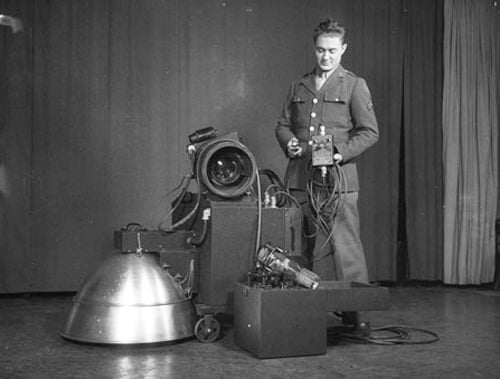
His MIT contact? None other than Harold “Doc” Edgerton, pioneer of high-speed photography, and whose work capturing bullets in flight and other such phenomena laid the groundwork for scientific photography as it exists today. Edgerton and his colleagues designed an absolutely enormous flash bulb, consisting of 30 inches of coiled, xenon-filled quartz glass, powered by racks of capacitors weighing up to 500 pounds each, so large, in fact, that they had to be mounted to the bomb rack of the carrying plane.
A camera flash is a particularly challenging device to design and build, and doubly so for those of the type Edgerton was involved with. In order to create a sharp burst of light with such a relatively long gap between conductors as exists in a xenon flash tube, you need a very large voltage-in the case of Edgerton’s aerial flash, upwards of 4,000 volts. The problem is that this high voltage needs to be delivered in an instant, rather than (relatively) slowly building up from nothing when a circuit is closed. Furthermore, the actual triggering system itself can’t be trusted to reliably deliver electricity in this manner, especially in large amounts, because electrical arcs between the two sides of the switch are likely when handling such high voltages.
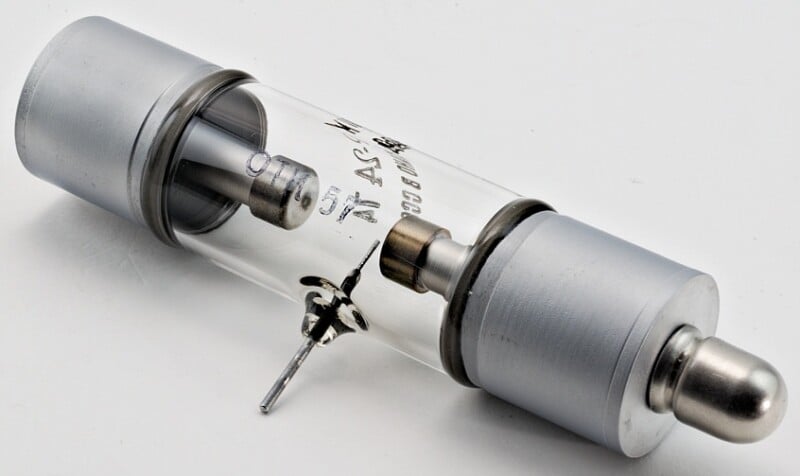
The solution is nothing short of genius-a triggered spark gap. These are special devices with a unique switching circuit inside that acts like a relay, allowing a low voltage to activate a high voltage. However, rather than using a physical connection to allow current to flow, which would fall victim to the unpredictable arcing problem previously mentioned, these operate on a principle just like the spark plugs in your car. When the switch is activated, a low-voltage spark jumps between two electrodes virtually instantaneously because its voltage differential is only small. This then ionizes the gas inside the tube, creating a highly-conductive pathway for the electricity on the high-voltage side of the circuit to jump between its own electrodes, creating an instantaneous voltage spike in precisely the manner needed for a gigantic flash bulb.
A Happy Little Accident
As it turns out, this kind of high-speed, high-current switching was exactly what the Manhattan Project was looking for to ensure that its nuclear bomb detonators were fast, precise, and reliable enough to create a perfect implosion of the core. When it came time to solve this problem, Army General Leslie Groves, in charge of overseeing the entirety of the Manhattan Project, enlisted the help of defense contractor Raytheon, which had been producing components for Edgerton’s aerial photography systems to perfect the spark-gap trigger for use in nuclear weapons. And as we know, both the Gadget used in the Trinity test and Fat Man used over the Japanese city of Nagasaki employed this exact type of device.
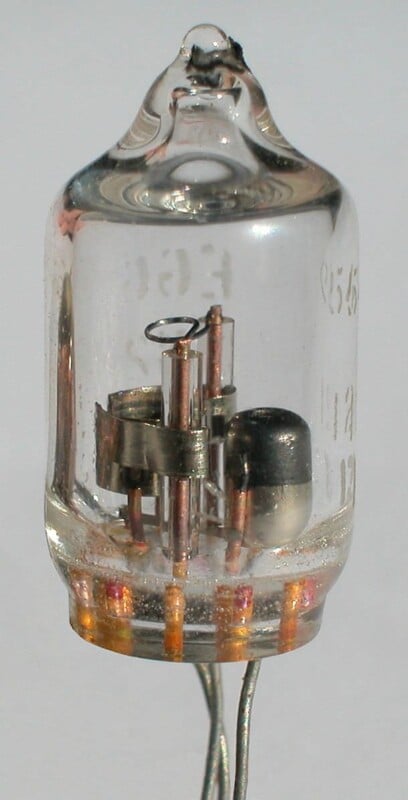
The technology would go on to be developed by Edgerton’s EG&G corporation and marketed as the “Krytron”, with the derivative “Sprytron” being designed to operate in highly irradiated environments that could result in the accidental triggering of the former device. While it’s unknown if they are still used in the most modern nuclear applications given their highly secretive nature, they are tightly regulated and known to have been technologically important until at least 1985, when Richard Smyth, a NATO consultant, was indicted for illegally shipping krytrons to Israel.
And the rest, as they say, is history.